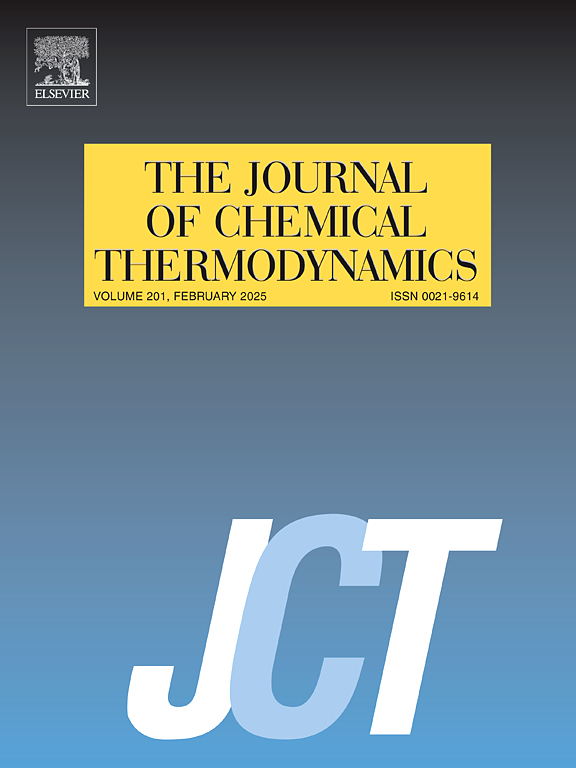Insight into behaviors of internal interactions and thermodynamic properties of binary mixtures composed of ether-functionalized ionic liquids and 1,4-butyrolactone or propylene carbonate
IF 2.2
3区 工程技术
Q3 CHEMISTRY, PHYSICAL
引用次数: 0
Abstract
A deeper comprehension of the mechanism behind various internal interactions and their influence on system properties encourages the utilization of ionic liquid mixture systems. In this work, the excess molar volume, viscosity deviation, change of electrical conductivity, and ionicity of both binary mixtures for N-methyl-N-methoxyethylpyrrolidinium bis(trifluoromethanesulfonyl)imide ([MOEMPYrr][TFSI]) ether-functionalized ionic liquids (ILs) with 1,4-butyrolactone (GBL) or propylene carbonate (PC) were systematically studied. The specific interactions between ILs and solvent molecules were investigated by using the COSMO-RS model in terms of DFT calculation. The results indicate that [MOEMPYrr]+ tends to act as a hydrogen bond donor and [TFSI]- tends to act as a hydrogen bond acceptor, and GBL (or PC) has a strong hydrogen bond acceptance ability. Furthermore, based on the radial distribution functions (RDFs) from molecular dynamics (MD) simulations, the H1 atom in [MOEMPYrr]+, the O2 atom in [TFSI]-, the O3 atom in GBL, and the O4 atom in PC are selected as reference sites to study the interaction between cations and anions (or solvent molecules). It is found that the interaction between anions and cations in the [MOEMPYrr][TFSI] + PC system is stronger than that in the [MOEMPYrr][TFSI] + GBL system, and the interaction between cations and GBL is stronger than that between cations and PC. This result further explains why the excess molar volumes (VE) of [MOMPYrr][TFSI] + GBL binary mixtures are greater than that of [MOMPYrr][TFSI] + PC binary mixtures from a microscopic perspective.
深入了解由醚官能化离子液体和 1,4-丁内酯或碳酸丙烯酯组成的二元混合物的内部相互作用行为和热力学性质
深入了解各种内部相互作用的机理及其对系统特性的影响,有助于对离子液体混合物系统的利用。本研究系统研究了 N-甲基-N-甲氧基乙基吡咯烷鎓双三氟甲磺酰亚胺([MOEMPYrr][TFSI])醚官能化离子液体(ILs)与 1,4-丁内酯(GBL)或碳酸丙烯酯(PC)二元混合物的过剩摩尔体积、粘度偏差、电导率变化和离子性。在 DFT 计算方面,采用 COSMO-RS 模型研究了离子液体与溶剂分子之间的特定相互作用。结果表明,[MOEMPYrr]+倾向于作为氢键供体,而[TFSI]-倾向于作为氢键受体,GBL(或 PC)具有很强的氢键接受能力。此外,根据分子动力学(MD)模拟的径向分布函数(RDF),选择[MOEMPYrr]+ 中的 H1 原子、[TFSI]- 中的 O2 原子、GBL 中的 O3 原子和 PC 中的 O4 原子作为研究阳离子和阴离子(或溶剂分子)相互作用的参考位点。结果发现,[MOEMPYrr][TFSI] + PC 体系中阴离子与阳离子之间的相互作用强于[MOEMPYrr][TFSI] + GBL 体系,而阳离子与 GBL 之间的相互作用强于阳离子与 PC 之间的相互作用。这一结果进一步解释了为什么从微观角度来看,[MOMPYrr][TFSI] + GBL 二元混合物的过量摩尔体积(VE)大于[MOMPYrr][TFSI] + PC 二元混合物的过量摩尔体积(VE)。
本文章由计算机程序翻译,如有差异,请以英文原文为准。
求助全文
约1分钟内获得全文
求助全文
来源期刊

Journal of Chemical Thermodynamics
工程技术-热力学
CiteScore
5.60
自引率
15.40%
发文量
199
审稿时长
79 days
期刊介绍:
The Journal of Chemical Thermodynamics exists primarily for dissemination of significant new knowledge in experimental equilibrium thermodynamics and transport properties of chemical systems. The defining attributes of The Journal are the quality and relevance of the papers published.
The Journal publishes work relating to gases, liquids, solids, polymers, mixtures, solutions and interfaces. Studies on systems with variability, such as biological or bio-based materials, gas hydrates, among others, will also be considered provided these are well characterized and reproducible where possible. Experimental methods should be described in sufficient detail to allow critical assessment of the accuracy claimed.
Authors are encouraged to provide physical or chemical interpretations of the results. Articles can contain modelling sections providing representations of data or molecular insights into the properties or transformations studied. Theoretical papers on chemical thermodynamics using molecular theory or modelling are also considered.
The Journal welcomes review articles in the field of chemical thermodynamics but prospective authors should first consult one of the Editors concerning the suitability of the proposed review.
Contributions of a routine nature or reporting on uncharacterised materials are not accepted.
 求助内容:
求助内容: 应助结果提醒方式:
应助结果提醒方式:


